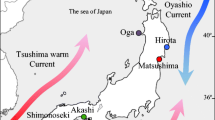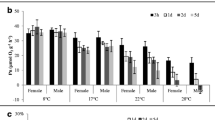Abstract
Recently, withering of farmed juvenile sporophytes of the kelp Undaria pinnatifida (Harvey) Suringar has led to reduced production of this species in northern Japan, possibly because of the high water temperature and low nutrient concentration in cultivation areas. This problem may be solved by introducing parental plants with greater tolerance to high temperature and low nutrient conditions. We examined the combined effects of various temperatures (15, 20, 24, and 27 °C) and nutrient availabilities (seawater enriched with 25 % PESI medium and non-enriched seawater) on the growth and survival of cultivated juvenile sporophytes (1–2 cm) collected from Matsushima Bay, Miyagi Prefecture in northern Japan and Naruto, Tokushima Prefecture in southern Japan. The relative growth rates of juvenile sporophytes from both locations were significantly greater at 15 and 20 °C than at 24 and 27 °C. The juvenile sporophytes cultured in enriched medium had significantly higher relative growth rates than those cultivated in non-enriched seawater. Dead juveniles were observed in non-enriched seawater at all temperatures and the survival percentage decreased with increasing seawater temperatures. Compared to the juvenile sporophytes from Matsushima Bay, those from Naruto showed greater tolerance to high temperature even under the low nutrient condition. These results suggest that the withering of juvenile sporophytes is caused by the combined effects of low nutrient availability and high temperature. A potential solution to this problem is to introduce ecotypes with greater tolerance to high temperature and low nutrient conditions from a warmer region of Japan.




Similar content being viewed by others
References
Akiyama K, Kurogi M (1982) Cultivation of Undaria pinnatifida (Harvey) Suringar, the decrease in crops from natural plants following crop increase from cultivation. Bull Tohoku Reg Fish Res Lab 44:91–100
Bird KT, Habig C, DeBusk T (1982) Nitrogen allocation and storage patterns in Gracilaria tikvahiae (Rhodophyta). J Phycol 18:344–348
Bolton J, Lüning K (1982) Optimal growth and maximal survival temperatures of Atlantic Laminaria species in culture. Mar Biol 87:131–135
Buggeln RG (1978) Physiological investigations on Alaria esculenta (Laminariales, Phaeophyceae). IV. Inorganic and organic nitrogen in the blade. J Phycol 14:156–160
Campbell SJ, Bité JS, Burridge TR (1999) Seasonal patterns in the photosynthetic capacity, tissue pigment and nutrient content of different developmental stages of Undaria pinnatifida (Laminariales, Phaeophyta) in Port Phillip Bay, South-Eastern Australia. Bot Mar 42:231–241
Chapman ARO, Craigie JS (1977) Seasonal growth in Laminaria longicruris: relations with dissolved inorganic nutrients and internal reserves of nitrogen. Mar Biol 40:197–205
Chapman ARO, Lindley JE (1980) Seasonal growth in Laminaria solidungula in the Canadian High Arctic in relation to irradiance and dissolved nutrient concentrations. Mar Biol 57:1–5
Chapman ARO, Markham JW, Lüning K (1978) Effects of nitrate concentration on the growth and physiology of Laminaria saccharina (Phaeophyta) in culture. J Phycol 14:195–198
Dean PR, Hurd CL (2007) Seasonal growth, erosion rates, and nitrogen and photosynthetic ecophysiology of Undaria pinnatifida (Heterokontophyta) in southern New Zealand. J Phycol 43:1138–1148
Dean TA, Jacobsen FR (1984) Growth of juvenile Macrocystis pyrifera (Laminariales) in relation to environmental factors. Mar Biol 83:301–311
Deysher LE, Dean TA (1986) In situ recruitment of sporophytes of giant kelp Macrocystis pyrifera (L.) Agardh CA: effects of physical factors. J Exp Mar Biol Ecol 103:41–63
Fletcher RL, Manfredi C (1995) The occurrence of Undaria pinnatifida (Phaeophyceae, Laminariales) on the south coast of England. Bot Mar 38:355–358
Gagne JA, Mann KH, Chapman ARO (1982) Seasonal patterns of growth and storage in Laminaria longicruris in relation to differing patterns of availability of nitrogen in the water. Mar Biol 69:91–101
Gerard VA (1982) Growth and utilization of internal nitrogen reserves by the giant kelp Macrocystis pyrifera in a low-nitrogen environment. Mar Biol 66:27–35
Gerard VA (1997) The role of nitrogen nutrition in high-temperature tolerance of the kelp Laminaria saccharina (Chromophyta). J Phycol 33:800–810
Hay CH (1990) The dispersal of sporophytes of Undaria pinnatifida by coastal shipping in New Zealand, and implications for further dispersal of Undaria in France. Brit Phycol J 25:301–313
Hay CH, Luckens PA (1987) The Asian kelp Undaria pinnatifida (Laminariales, Phaeophyta) found in a New Zealand harbor. NZ J Bot 57:329–332
Jackson GA (1977) Nutrients and production of the giant kelp Macrocystis pyrifera off southern California. Limnol Oceanogr 22:979–995
Lapointe BE (1981) The effects of light and nitrogen no growth, pigment content and biochemical composition of Gracilaria folifera v. angustissima (Gigartinales, Rhodophyta). J Phycol 17:90–95
Lee JA, Brinkhuis BH (1986) Reproductive phenology of Laminaria saccharina (L.) Lamour. (Phaeophyta) at the southern limit of its distribution in the northwestern Atlantic Ocean. J Phycol 22:276–285
Levy I, Gantt E (1990) Development of photosynthetic activity in Porphyridium purprueum (Rhodophyta) following nitrogen starvation. J Phycol 26:62–68
Lignell R, Seppälä J, Kuuppo P, Tamminen T, Anderson T, Gismervik I (2003) Beyond bulk properties: responses of coastal summer plankton communities to nutrient enrichment in the northern Baltic Sea. Limnol Oceanogr 48:189–209
Lingnell A, Pedersen M (1987) Nitrogen metabolism in Gracilaria secundata (Harv.). Hydrobiologia 151/152:431–441
Liu F, Pang SJ (2010) Performances of growth, photochemical efficiency, and stress tolerance of young sporophytes from seven populations of Saccharina japonica (Phaeophyta) under short-term heat stress. J Appl Phycol 22:221–229
Mizuta H, Maita Y, Yanada M (1992) Seasonal changes of nitrogen metabolism in the sporophyte of Laminaria japonica (Phaeophyceae). Nippon Suisan Gakk 58:2345–2350
Mizuta H, Torii K, Yamamoto H (1997) The relationship between nitrogen and carbon contents in the sporophytes of Laminaria japonica (Phaeophyceae). Fish Sci 63:553–556
Ohno M (2004) Biology and technology of economic seaweeds. Uchida Rokakuho Press, Tokyo, p 44, in Japanese
Pang SJ, Jin ZH, Sun JZ, Gao SQ (2007) Temperature tolerance of young sporophytes from two populations of Laminaria japonica revealed by chlorophyll fluorescence measurements and short-term growth and survival performances in tank culture. Aquaculture 262:493–503
Saito Y (1972) Effects of environmental factors on mophological characteristics of Undaria pinnatifida and the breeding of hybrids in the genus Undaria. In: Abott IA, Kurogi M (eds) Contributions to the systematics of benthic marine algae of the north Pacific. Japanse Society of Phycology, Kobe, pp 117–133
Saito Y (1975) Undaria. In: Tokida J, Hirose H (eds) Advance of phycology in Japan. Springer, Berlin, pp 304–320, Dr. W. Junk, Hague
Serisawa Y, Yokohama Y, Aruga Y, Tanaka J (2001) Photosynthesis and respiration in bladelets of Ecklonia cava Kjellman (Laminariales, Phaeophyta) in two localities with different temperature conditions. Phycol Res 49:1–11
Serisawa Y, Yokohama Y, Aruga Y, Bellgrove A (2004) Photosynthetic performance of transplanted ecotypes of Ecklonia cava (Laminariales, Phaeophyta). J Appl Phycol 16:227–235
Smit AJ (2004) Medicinal and pharmaceutical uses of seaweed natural products: a review. J Appl Phycol 16:245–262
Staehr PA, Wernberg T (2009) Physiological responses of Ecklonia radiata (Laminariales) to a latitudinal gradient in ocean temperature. J Phycol 45:91–99
Stuart MD, Hurd CL, Brown MT (1999) Effects of seasonal growth rate on morphological variation of Undaria pinnatifida (Alariaceae: Phaeophyceae). Hydrobiologia 398/399:191–199
Tatewaki M (1966) Formation of a crustose sporophyte with unilocular sporangia in Scytosiphon lomentaria. Phycologia 6:62–66
Tokuda H, Kawashima S, Ohno M, Ogawa H (1994) Cultivation of “Wakame”, Undaria pinnatifida. In: Seaweeds of Japan. Midori Shobo Co, Ltd, Tokyo, p 98, in Japanese
Tom Dieck I (1993) Temperature tolerance and survival in darkness of kelp gametophytes (Laminariales, Phaeophyta): ecological and biogeographic implications. Mar Ecol Prog Ser 100:253–264
Troell M, Robertson-Anderson DV, Anderson RJ, Bolton JJ, Maneveldt G, Halling C, Probyn T (2006) Abalone farming in South Africa: perspectives on kelp resources, abalone feed, potential for on-farm seaweed production and socio-economic benefits. Aquaculture 257:266–281
Wheeler PA, North WJ (1980) Effect of nitrogen supply on nitrogen content and growth rates of juvenile Macrocystis pyrifera sporophytes. J Phycol 16:577–582
Wheeler PA, Srivastava LM (1984) Seasonal nitrate physiology of Macrocystis integrifolia Bory. J Exp Mar Biol Ecol 76:35–50
Yamanaka R, Akiyama K (1993) Cultivation and utilization of Undaria pinnatifida (wakame) as food. J Appl Phycol 5:249–253
Zemke-White WL, Ohno M (1999) World seaweed utilisation: an end of century summary. J Appl Phycol 11:369–376
Zimmerman RC, Kremer JN (1984) Episodic nutrient supply to a kelp forest ecosystem in Southern California. J Mar Res 42:591–604
Zimmerman RC, Kremer JN (1986) In situ growth and chemical composition of the giant kelp, Macrocystis pyrifera, response to temporal changes in ambient nutrient availability. Mar Ecol Prog Ser 27:277–285
Zimmerman RC, Robertson DL (1985) Effects of El Niño on local hydrography and growth of the giant kelp, Macrocystis pyrifera, at Santa Catalina Island, California. Limnol Oceanogr 30:1298–1302
Acknowledgments
We sincerely thank the staffs at Miyagi Prefecture Fisheries Technology Institute for providing seawater for culture experiment. We also thank Professor O. Nishimula and Mr. Chiba of Tohoku University for helping with the analysis of seawater nutrient concentration.
Author information
Authors and Affiliations
Corresponding author
Rights and permissions
About this article
Cite this article
Gao, X., Endo, H., Taniguchi, K. et al. Combined effects of seawater temperature and nutrient condition on growth and survival of juvenile sporophytes of the kelp Undaria pinnatifida (Laminariales; Phaeophyta) cultivated in northern Honshu, Japan. J Appl Phycol 25, 269–275 (2013). https://doi.org/10.1007/s10811-012-9861-x
Received:
Revised:
Accepted:
Published:
Issue Date:
DOI: https://doi.org/10.1007/s10811-012-9861-x




